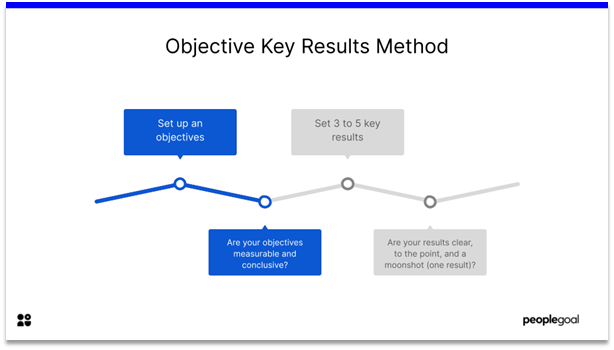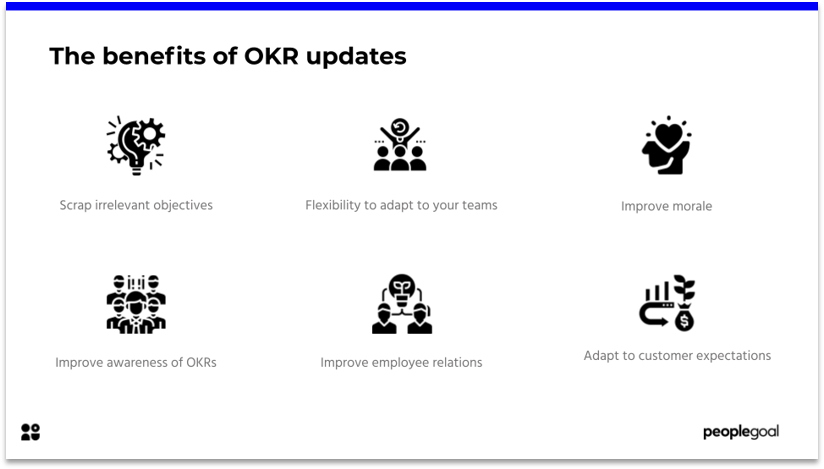The COVID-19 crisis has changed the way we work. Remote working has become the norm; with some organizations better equipped than others to handle its unique challenges. Going forward, company leaders must implement the right work-from-home strategies to ensure a productive approach to remote work. When used correctly, the Objective and Key Results (OKRs) framework allows teams to overcome the main challenges of remote working, setting them on the path to success.

According to a recent survey, 74% of CFOs expect some of their employees to continue to work from home even after the pandemic ends. Whilst many have discovered the benefits of working from home, others have found the process difficult and disruptive. Reported side effects of remote work include reduced communication, working in silos, and lack of direction. However, they can be remedied with the introduction of an effective objectives and key results framework which inspires excellent performance, even at home.
What are Objectives and Key Results?
If you are new to the methodology, Objectives and Key Results – otherwise known as OKRs – is a simple yet effective process of management by objectives created by Andy Grove and popularized by John Doerr. Used by a range of disruptive tech companies such as Google, Intel, Spotify and Airbnb to connect teams and individuals with the wider business goals, OKRs are also favoured by startups looking to achieve scalability.
An example of an objective could be, ‘achieve 1000 new software subscriptions per month’. Next you must decide a direct, measurable key result that defines the success of the objective. For example, ‘increase website traffic to 100k site visitors per month’.
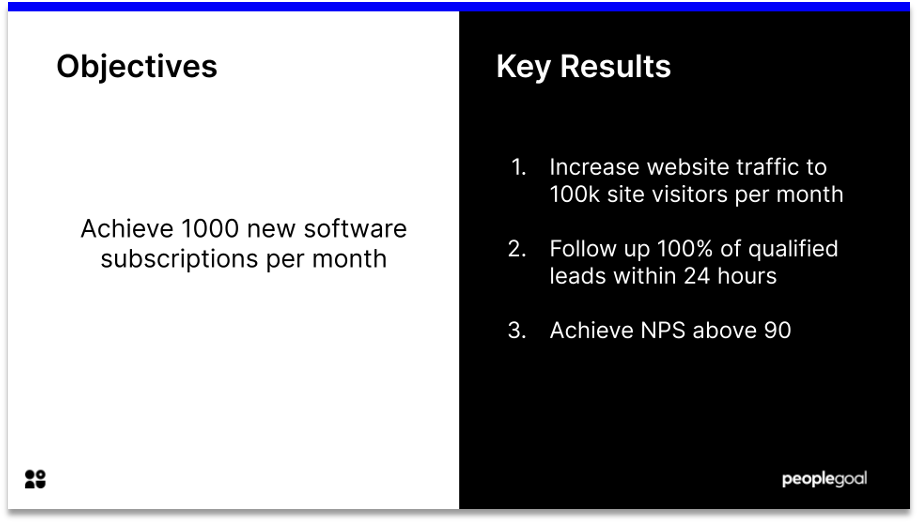
What are the Advantages of Setting Objective and Key Results for the Remote Team?
Whilst some remote teams may feel isolated whilst working from home, OKRs are a practical way to keep the team focused and aligned. Creating individual success metrics to analyze goals is a really useful way to track progress and encourage personal growth. This section will discuss some of the key benefits that can be achieved by setting OKRs for your remote team.
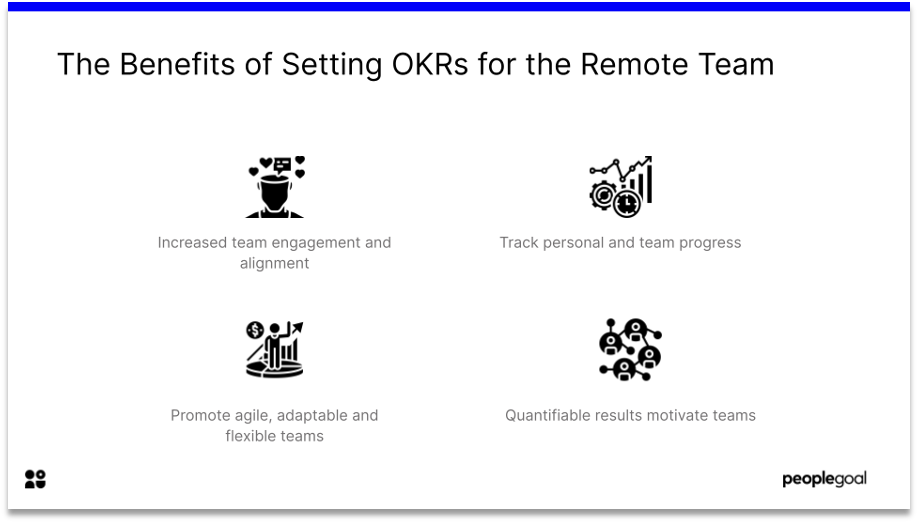
OKRs encourage team engagement and alignment
Working remotely can hinder some teams who previously relied on face to face methods of goal-setting. However, the OKR framework helps align remote teams by facilitating communication and setting common goals. Setting ambitious goals that can be aligned at both team level and company level encourages productivity, boosts motivation and improves employee engagement. The end result is a more engaged team who will achieve more impactful results.
OKRs help track personal and team progress
Some employees report lower productivity rates whilst working from home as it can be hard to keep on track outside of the office environment. Having clearly defined and measurable goals provides employees with clarity on what they should aspire to achieve and clear direction. During regular OKR check-ins, employees can report on their progress, go over any difficulties that they had and discuss how to adapt their approach.

The OKR methodology promotes agile, adaptable and flexible teams
The world is changing fast, and companies that want to survive and flourish must be capable of agile learning and adapting to change. OKRs can be set weekly, monthly or quarterly depending on the scale of the objectives. The methodology has a rapid turn around, and whilst some targets can be achieved quickly, it is also important to modify and improve processes that aren’t delivering the required results.
Quantifiable results motivate teams
Focusing on measured outcomes ensures that decisions are data driven, based on facts and not purely opinion. If OKRs are set and executed well, teams will see real and measurable progress in their work and their colleagues’ work. This will undoubtedly provide a morale boost for remote teams.
Objectives and Key Results Best Practices for Remote Teams
Here are some best practices for implementing the OKR goal-setting methodology within your remote team.
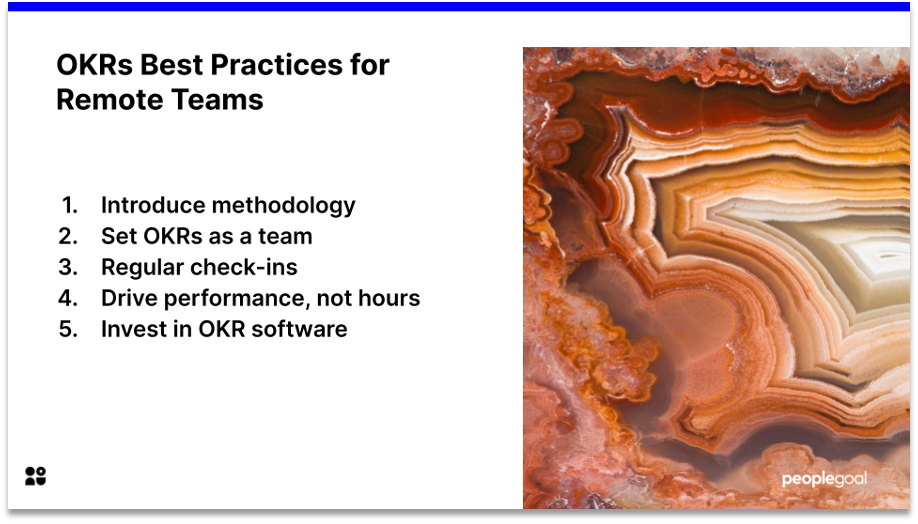
1. Introduce methodology
First of all, it is essential that all team members understand the OKR methodology and thoroughly grasp what benefits measurable goal-setting will bring the team. If the team understands the importance of OKRs, they are more likely to engage with them effectively.
2. Set OKRs as a team
OKRs should be created and executed as a team. Hold a conference call to brainstorm ideas and discuss company objectives. It is good practice to warn employees beforehand, and encourage them to bring ideas to the meeting. This way, everyone will feel prepared and ready to actively participate in the discussion.
After setting the objectives, it is important to work together to devise a list of measurable outcomes that will help define the success of the objective. This could be done in a follow up meeting, giving the team time to digest the objectives and draft some ideas.
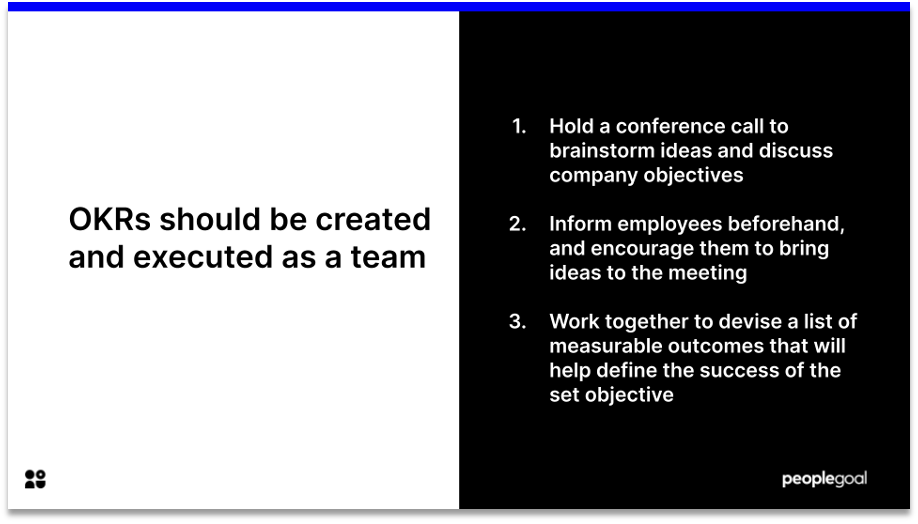
3. Regular check-ins
Setting the objectives is only part of the job, now it’s time to execute them. It is important to track progress by having regular check-ins with the team to find out what they have been up to. If any challenges have arisen, you can work through them together. It is important to strike a balance between engagement and freedom, allowing employees to achieve their goals without micromanaging them every step of the way.
4. Drive performance, not hours
OKRs replace the outdated ‘hours at work’ productivity model with a results driven performance based goal setting methodology. To skyrocket remote teams’ productivity you should set stretch goals on different levels. Break down larger projects into smaller sections, set weekly objectives and a specific number of goals for each week. Set fair deadlines for specific tasks and track how long it takes to complete them, taking care to talk to team members who fall behind and adjust the goals accordingly.
5. Consider investing in OKR software
If you wish to set goals at an organizational level and cascade objectives down to departments, it would be worth investing in OKR software for high performing teams. Using a performance management platform will reduce manual tasks, and allow different people to weigh in on the objective setting. Bonus points if your software can tie OKRs into the performance review!
Common Challenges When Implementing Objectives and Key Results – and How To Overcome Them
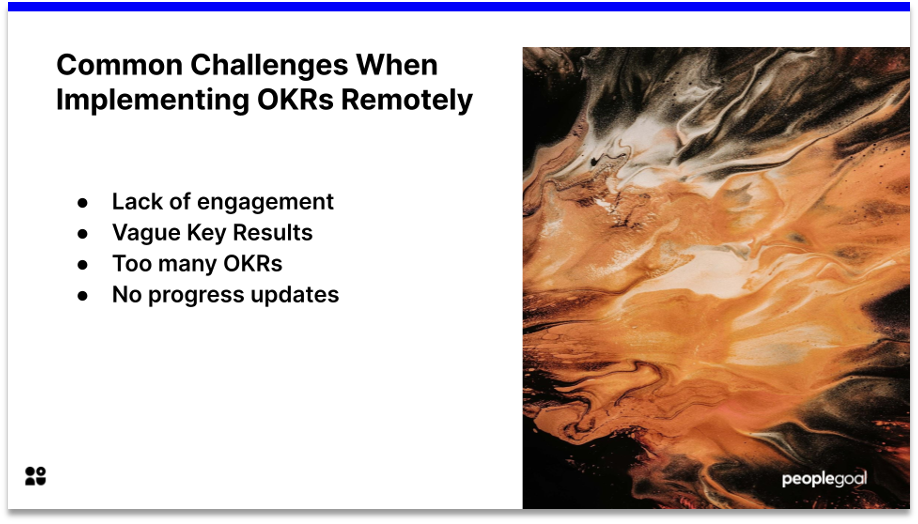
Team members not engaging with the OKR process
The organization will not see the real value of the framework unless all members of the team actively engage with the process. To ensure that people participate, it is important to dedicate time in the form of virtual calls to explain the process. Give your team time to come up with their own OKRs; people are always more engaged when they discuss their own ideas.
Key Results that are not clearly defined
One of the most common mishaps when setting OKRs is having vague key results. It is essential to set quantifiable and measurable results, for example: ‘reply to 100% of customer enquiries within 24 hours’ or ‘achieve a NPS of 90’. You should also make sure that objectives are time bound.
Too many OKRs
It is easy to become inundated by a long list of challenging objectives. Instead, try and work in rules of three. Three objectives per team member, and three key key results per objective. This way, employees will be challenged but not overwhelmed.
No progress updates
It is all very well setting objectives, but with no opportunity to discuss and review these objectives as time goes on they will fall to the background. It is important to set regular check-ins with the team to keep on top of OKRs.
Strive for Excellence with Objectives and Key Results
Managing a remote team and implementing Objectives and Key Results both involve different challenges. However, when executed correctly, OKRs are a very effective way to achieve company objectives and boost productivity whilst working remotely.
The key is to not rush the implementation process. Take time to talk through each stage with your team. See it as a long term process that will improve productivity and grow the business; not a quick fix for a difficult quarter.
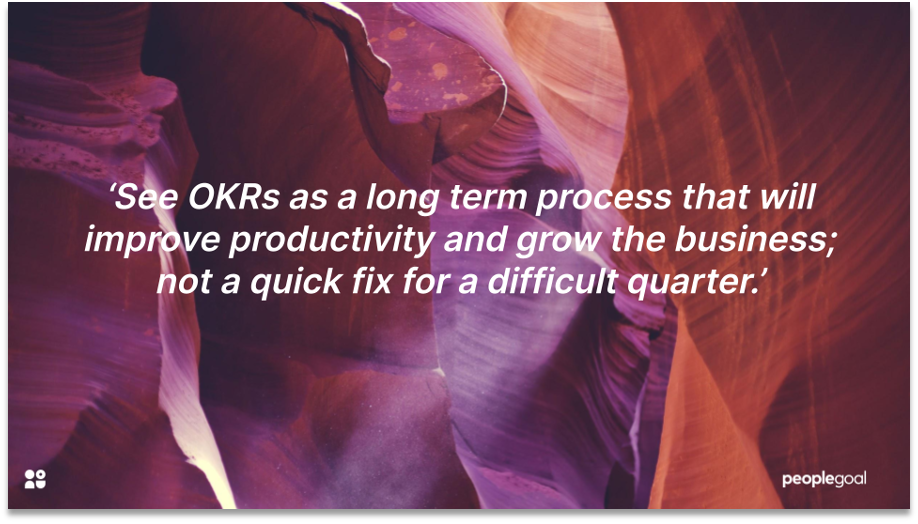
For more information on OKRs, check out our essential guide.
Need help setting up the OKRs framework for you team? Book a demo with PeopleGoal today!
Ready to 3x Your Teams' Performance?
Use the best performance management software to align goals, track progress, and boost employee engagement.

